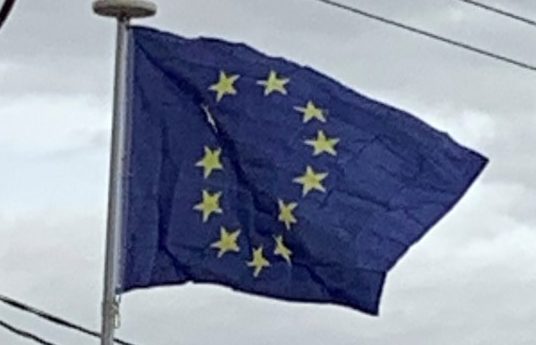Since its adoption by the European Union, it has become broadly associated with the supranational organisation, due to its high profile and heavy usage of the emblem. It has also been used by pro-EU protestors in the colour revolutions of the 2000s, e.g., in Belarus (2004) or Moldova.
Design:
The graphical specifications given by the EU in 1996 describe the design as: “On an azure field a circle of twelve golden mullets, their points not touching.”[7]
According to graphical specifications published online by the Council of Europe in 2004, the flag is rectangular with 2:3 proportions: its fly (width) is one and a half times the length of its hoist (height). Twelve yellow stars are centred in a circle (the radius of which is a third of the length of the hoist) upon a blue background. All the stars are upright (one point straight up), have five points and are spaced equally, like the hour positions on the face of a clock. The diameter of each star is equal to one-ninth of the height of the hoist.
Colors:
The colours are regulated in the 1996 guide by the EC, and equivalently in the 2004 guide by the Council of Europe. The base colour of the flag is defined as Pantone “Reflex Blue”, while the golden stars are portrayed in Pantone “Yellow”:
Symbolism:
The Council of Europe gave the 1955 flag a symbolic description in the following terms:
Against the blue sky of the Western world, the stars represent the peoples of Europe in a circle, a symbol of unity. Their number shall be invariably set at twelve, the symbol of completeness and perfection. The number of stars is not related to the number of member states of the EU (although the EU happened to have 12 member states at the time of Maastricht Treaty).
History:
The twelve-star “flag of Europe” was designed in 1950 and officially adopted by the Council of Europe in 1955. The same flag was adopted by the European Parliament in 1983. The European Council adopted it was an “emblem” for the European Communities in 1985. Its status in the European Communities was inherited by the European Union upon its formation in 1993. The proposal to adopt it as official flag of the European Union failed with the ratification of the European Constitution in 2005, and mention of all emblems suggesting statehood was removed from the Treaty of Lisbon of 2007, although sixteen member states signed a declaration supporting the continued use of the flag. In 2007, the European Parliament officially adopted the flag for its own use.
